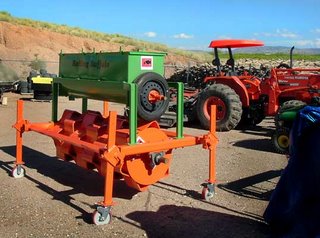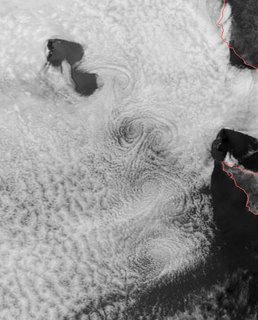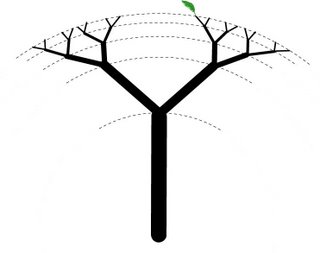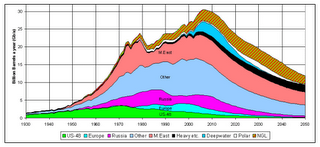By Douglas Barnes
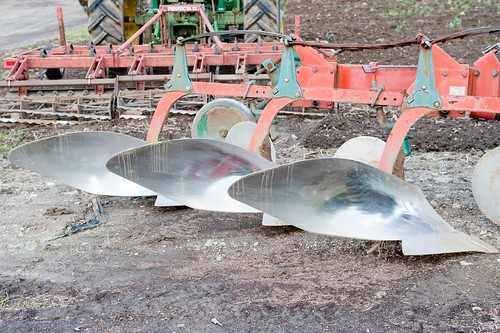 I just had the misfortune of reading Robert Paarlberg’s article Attention Whole Foods Shoppers in Foreign Policy in which he pooh-poohs what he thinks is “sustainable” agriculture. What is the prescription from this political scientist who sits on the Biotechnology Advisory Council to the CEO of Monsanto? Why, more industrial agriculture, of course! While I find many faults and outright falsehoods in the story, I shall reserve my critique to only the most egregious of errors in the piece to avoid making a book out of this.
I just had the misfortune of reading Robert Paarlberg’s article Attention Whole Foods Shoppers in Foreign Policy in which he pooh-poohs what he thinks is “sustainable” agriculture. What is the prescription from this political scientist who sits on the Biotechnology Advisory Council to the CEO of Monsanto? Why, more industrial agriculture, of course! While I find many faults and outright falsehoods in the story, I shall reserve my critique to only the most egregious of errors in the piece to avoid making a book out of this.First off, I suppose that I should praise Paarlberg for having the courage to so publicly demonstrate that he has no clue as to the meaning of sustainable. He makes the claim that
“[S]ustainable food” in the future must be organic, local, and slow. But guess what: Rural Africa already has such a system, and it doesn’t work. Few smallholder farmers in Africa use any synthetic chemicals, so their food is de facto organic.
For the benefit of the reader, I shall give that definition in a manner that is clear and concise and has a useable metric behind it: A system is sustainable if it can capture and store more energy over its lifetime than it consumes in its creation and maintenance. A system can be organic and still be unsustainable, and many are, especially when externalised costs are properly included in the calculations. As far as the modern farming he advocates goes, it is virtually always, if not always unsustainable.
Why is that important? It is important to realise that the word “sustainable” can also be traded for the word “survivable.” Modern conventional agriculture is wholly dependent on fossil fuels to exist. In fact, ten kilocalories of exosomatic energy – energy outside of human labour – are needed to provide a U.S. consumer with one kilocalorie of uncooked food energy.
Now, I fully admit that I am not an accountant, so take the following with a grain of salt. It seems to me that if a system relies on consuming over ten energy units of a finite energy resource to produce one energy unit of an item, that system is neither sustainable nor survivable in the long term. I say “over ten times” because when losses from cooking, soil and water degradation and the documented adverse health effects of the modern food system are factored in, the costs increase.
I have trouble with Paarlberg's the assertion that we have two choices for our future: The energy-intensive approach to farming in the so-called developed world, or traditional agricultural approaches. It is worth pointing out that many of these “traditional” approaches are the not-quite sustainable approaches developed in the temperate world and exported inappropriately to tropical, sub-tropical, arid and semi-arid regions of the world via colonialism.
While this does make arguing the case easier, it is a logical fallacy known as a false dichotomy. A false dichotomy is an argument that reduces an argument to just two options, ignoring all other options. In this case, it offers only labour-intensive approaches to farming or energy-intensive approaches. Totally ignored is a design-intensive approach to farming. More on this later.
 Paarlberg writes of “bringing improved seeds and fertilizers to traditional farmers,” but what are these “improved seeds”? Many of them are genetically modified seeds that he has advocated elsewhere. These crops have never been tested for long term health effects on humans, although the amount of research finding harm to animals fed GMOs is increasing. This is to say nothing about the hubris of randomly jamming transgenes into crop DNA when the science of genetics is just reaching the point where we understand that we don’t really understand what a gene is. In other cases, it means promoting the spread genetically homogeneous seeds. Luckily, this project is not complete. If it were, we would not have the 100 or so varieties of wheat resistant to the strain of Puccinia graminis tritici that popped up in Uganda in 1999, more commonly known as Ug99 - a fungus that threatens world wheat supplies.
Paarlberg writes of “bringing improved seeds and fertilizers to traditional farmers,” but what are these “improved seeds”? Many of them are genetically modified seeds that he has advocated elsewhere. These crops have never been tested for long term health effects on humans, although the amount of research finding harm to animals fed GMOs is increasing. This is to say nothing about the hubris of randomly jamming transgenes into crop DNA when the science of genetics is just reaching the point where we understand that we don’t really understand what a gene is. In other cases, it means promoting the spread genetically homogeneous seeds. Luckily, this project is not complete. If it were, we would not have the 100 or so varieties of wheat resistant to the strain of Puccinia graminis tritici that popped up in Uganda in 1999, more commonly known as Ug99 - a fungus that threatens world wheat supplies.And then there are the synthetic fertilisers he wants to bring to “traditional farmers.” I’ve written about this before, so the question is, why does he want to destroy soil organic carbon content, particularly when that is so vital to soil fertility and the ability of soil to hold water?
 |
| Image from AATF |
Paarlberg is so intent on focusing on it. No, agriculture there isn’t sustainable. There systems are bleeding energy on the whole. Consider the case of
So, the solution could be spend millions on research to develop a proprietary technology (i.e. GM crop) allowing plants to survive dousing with expensive and dangerous herbicides, ignoring the problem (neglect of soil health). Or the solution could be the one that has actually been put into practice: Treat soil fertility seriously by inter-cropping corn in an alley-cropping regime such as the Taungya system, inter-planting with nitrogen-fixing trees such as Leucaena that can also provide fodder, wood and fuel. The use of nitrogen-fixing plants, green manure and mulching are an effective way to address fertility without relying heavily or solely on animal manure, which Paarlberg asserts organic agriculture is dependent upon. Additionally, human wastes can be composted and returned to the land. This closes the fertility loop while tackling the water-borne disease problem so prevalent in Africa. Unfortunately, the latter, sustainable approach does not make money for industrial agribusiness.
 Paarlberg also writes of “learning to appreciate the modern, science-intensive, and highly capitalized agricultural systems we’ve developed in the West.” Well, no one who knows me or has read my articles in this blog would accuse me of being unappreciative of science, but it is true that I do not appreciate Western agriculture. Why would I appreciate a system that has ruined more soil more quickly than at any time in history, reduced nutrition (more on this later), contaminated groundwater and riparian systems, ruined farming as a way of life, while subjecting an unwilling population to ongoing experimentation that may be making them infertile, among other things (i.e. GM crops)? All for a system that is so inefficient that it requires 10 units of external energy (not counting human labour) to produce one unit of food energy and cannot survive without massive public subsidy? No thanks. You can keep that system.
Paarlberg also writes of “learning to appreciate the modern, science-intensive, and highly capitalized agricultural systems we’ve developed in the West.” Well, no one who knows me or has read my articles in this blog would accuse me of being unappreciative of science, but it is true that I do not appreciate Western agriculture. Why would I appreciate a system that has ruined more soil more quickly than at any time in history, reduced nutrition (more on this later), contaminated groundwater and riparian systems, ruined farming as a way of life, while subjecting an unwilling population to ongoing experimentation that may be making them infertile, among other things (i.e. GM crops)? All for a system that is so inefficient that it requires 10 units of external energy (not counting human labour) to produce one unit of food energy and cannot survive without massive public subsidy? No thanks. You can keep that system.He also asserts that organic has been found to be no more nutritious than conventionally grown produce and provides two sources to back him. I’ll provide two of my own. The first is a study by chemist Donald R. Davis published last year in HortScience in which it was found that
Recent studies of historical nutrient content data for fruits and vegetables spanning 50 to 70 years show apparent median declines of 5% to 40% or more in minerals, vitamins, and protein in groups of foods, especially in vegetables.
The second study was also released last year by the UK’s Food Standards Agency. The study omitted numerous studies showing higher nutrition in organically grown food and made the claim that there are “no important differences in the nutrition content , or any additional health benefits, of organic food when compared with conventionally produced food.” So, why am I citing this as support for my argument? Because despite the FSA’s characterisation of the study, the study found that organic produce had 53.6% more beta-carotene, 38.4% flavonoids, 13.2% more phenolic compounds, 12.7% more protein, 11.3% more zinc, 10.5% more sulphur, 8.7% more sodium, 8.3% more copper, 7.1% more magnesium, 6% more phosphorus, and 2.5% more potassium. It sure would help us to form a reasonable opinion about the issue, if the people presenting the evidence were even remotely honest. But I digress.
Without a shred of evidence, he makes the claim that "Organic field crops also have lower yields per acre." Well, the Rodale trials don't square with that claim very wall. They found that
After a transition period of about four years, crops grown under organic systems yield as well as and sometimes better than crops grown under the conventional system. Moreover, organic systems can out-produce the conventional system in years of less-than-optimal growing conditions such as drought. [The Rodale Institute Farming Systems Trial: The First 15 Years, The Rodale Institute, Kutztown, 1999]
As mentioned, Paarlberg assumes that the only way to address soil fertility is through animal manure, which would require more forests to be cut down in order to provide for the animals, saying “Mass deforestation probably isn’t what organic advocates intend.” Actually, increased trees cover through agroforestry is what I intend, though I don’t speak for organic agriculture.
Our simple monoculture approach to production is a product of simple thinking. It’s time to stop burning those calories on either back-breaking labour or on producing synthetics and the machines to spread them around, and start spending it on brain power as outlined in the approach to Striga above.













